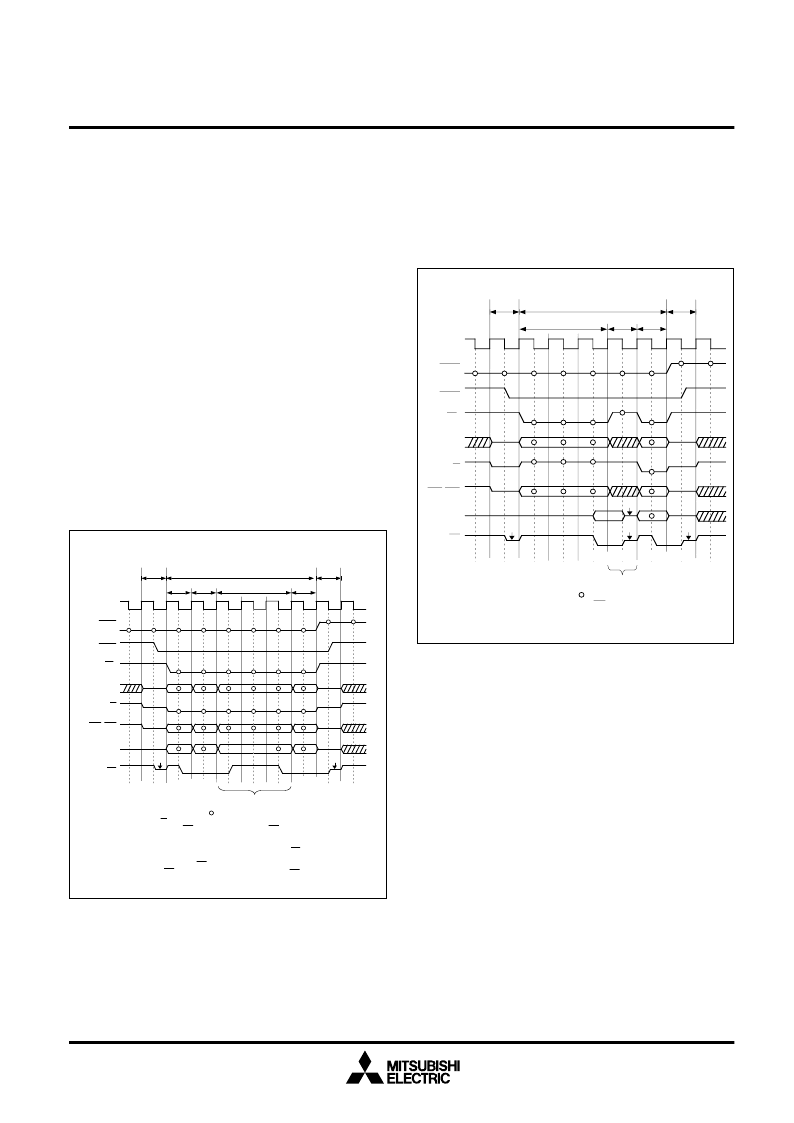- 您現(xiàn)在的位置:買賣IC網(wǎng) > PDF目錄370837 > M32000D4 (Mitsubishi Electric Corporation) SINGLE CHIP 32 BIT CMOS MICROCOMPUTER PDF資料下載
參數(shù)資料
| 型號: | M32000D4 |
| 廠商: | Mitsubishi Electric Corporation |
| 英文描述: | SINGLE CHIP 32 BIT CMOS MICROCOMPUTER |
| 中文描述: | 單芯片32位CMOS微機(jī) |
| 文件頁數(shù): | 25/45頁 |
| 文件大?。?/td> | 535K |
| 代理商: | M32000D4 |
第1頁第2頁第3頁第4頁第5頁第6頁第7頁第8頁第9頁第10頁第11頁第12頁第13頁第14頁第15頁第16頁第17頁第18頁第19頁第20頁第21頁第22頁第23頁第24頁當(dāng)前第25頁第26頁第27頁第28頁第29頁第30頁第31頁第32頁第33頁第34頁第35頁第36頁第37頁第38頁第39頁第40頁第41頁第42頁第43頁第44頁第45頁

SINGLE-CHIP 32-BIT CMOS MICROCOMPUTER
MITSUBISHI MICROCOMPUTERS
M32000D4AFP
25
("L" output)
("L" output)
"Hi-z"
"Hi-z"
"Hi-z"
"Hi-z"
"Hi-z"
"Hi-z"
"Hi-z"
"Hi-z"
"Hi-z"
"Hi-z"
8
CLKIN
HREQ
BCH, BCL
D0 - D15
DC
R/W
hold shift
hold
return
HACK
A8 - A30
CS
write
write
write
write
Note:
"Hi-z" means high impedance, and indicates sampling timing.
The value of the R/W signal that controls the data direction of the bus interface
cannot be changed during CS="L". Hold this value while CS="L".
Also, where marked above with
8
, 3 to 7 CLKIN clock periods are necessary for writing
operation to internal DRAM crossing an 128-bit boundary. Hold the input value of the
During these wait cycle period, CS cannot be returned to "H" level (the access
cannot be aborted). CS can only be returned to a "H" level after DC is driven to "L".
When the M32000D4AFP is in the hold state and an "L" level is input
to CS, the M32000D4AFP interprets it as a bus access request to
the internal DRAM. In this case, when the R/W signal is at an "L"
level, the memory controller drives a write cycle to the internal DRAM.
Byte data control is specified by the BCH and BCL signals. Only data
in the byte positions for which an "L" level is input to BCH or BCL are
written. When writing is complete, an "L" level DC signal is output.
The M32000D4AFP stores the requested data in the 128-bit data
buffer of the BIU, before writing to the internal DRAM. This reduces
the number of accesses to the internal DRAM when a request to
writing to consecutive addresses is made, and improves bus cycle
throughput. Consecutive write cycles within an 128-bit boundary are
completed in 1 CLKIN clock period. 3 to 7 CLKIN clock periods are
necessary for a write access crossing an 128-bit boundary when
writing to the internal DRAM. Once the external bus master write
cycle has been driven, it cannot be aborted. When an "L" level is
input to CS and an access has started, the values of this and other
control signals should be held during the wait cycles (that is while DC
= "H"). After DC outputs an "L" level (access complete), return CS to
the "H" level between the CLKIN falling edge corresponding to the
last write cycle and the following CLKIN falling edge. Return HREQ
to the "H" level to return the M32000D4AFP to the normal operation
mode from the hold state either at the same time as or after CS is
returned to the "H" level.
When the external bus master makes an access, the value of the
R/W signal that controls the data direction of the bus interface can-
not be changed during CS="L". Therefore, read cycles and write cycles
cannot be mixed while CS = "L". When starting a write cycle follow-
ing after a read cycle and starting a read cycle following a write cycle,
keep the CS signal at an "H" level for at least 1 CLKIN.
Fig. 24 Write bus cycle to internal DRAM
Fig. 25 Read/write bus cycle
CLKIN
HREQ
BCH, BCL
D0 - D15
DC
R/W
hold shift
hold
return
HACK
A8 - A30
CS
("L" output)
read
CS = "H"
write
("L" output)
"Hi-z"
"Hi-z"
"Hi-z"
"Hi-z"
"Hi-z"
"Hi-z"
"Hi-z"
"Hi-z"
"Hi-z"
8
"Hi-z"
"Hi-z"
Note:
"Hi-z" means high-impedance, and indicates sampling timing.
Also, where marked above with
8
, keep CS signal to "H" at least 1 CLKIN when
starting a write bus cycle after a read bus cycle or a read bus cycle after a write
bus cycle.
"Hi-z"
相關(guān)PDF資料 |
PDF描述 |
|---|---|
| M32000D4AFP | SINGLE CHIP 32 BIT CMOS MICROCOMPUTER |
| M32170F3VFP | SINGLE-CHIP 32-BIT CMOS MICROCOMPUTER |
| M32174F3VFP | SINGLE-CHIP 32-BIT CMOS MICROCOMPUTER |
| M32170F3VFG | 32-BIT RISC SINGLE-CHIP MICROCOMPUTER |
| M32170F3VWG | 32-BIT RISC SINGLE-CHIP MICROCOMPUTER |
相關(guān)代理商/技術(shù)參數(shù) |
參數(shù)描述 |
|---|---|
| M32000D4AFP | 制造商:MITSUBISHI 制造商全稱:Mitsubishi Electric Semiconductor 功能描述:SINGLE CHIP 32 BIT CMOS MICROCOMPUTER |
| M32000D4BFP-80 | 制造商:MITSUBISHI 制造商全稱:Mitsubishi Electric Semiconductor 功能描述:SINGLE-CHIP 32-BIT CMOS MICROCOMPUTER |
| M32002AGLJ | 制造商:MTRONPTI 制造商全稱:MTRONPTI 功能描述:9x14 mm, 3.3/2.5/1.8 Volt, PECL/LVDS/CML, VCXO |
| M32002AGMJ | 制造商:MTRONPTI 制造商全稱:MTRONPTI 功能描述:9x14 mm, 3.3/2.5/1.8 Volt, PECL/LVDS/CML, VCXO |
| M32002AGPJ | 制造商:MTRONPTI 制造商全稱:MTRONPTI 功能描述:9x14 mm, 3.3/2.5/1.8 Volt, PECL/LVDS/CML, VCXO |
發(fā)布緊急采購,3分鐘左右您將得到回復(fù)。